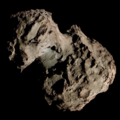Observational history
Zanotti spotted the comet in the constellation of Lynx on 27 May. He described it as a magnitude 3 star surrounded by nebulosity, while a tail 2 degrees long was spotted using a telescope. Zanotti followed the comet with the naked eye until 17 August, when it was only visible via a telescope. He last observed the comet the next day. It was also observed by James Bradley from 30 May to 10 June and Fuhrmann from June 8 to June 19. [4]
The parabolic orbit calculated by Nicolas-Louis de Lacaille indicates it passed perihelion on 17.9 June. The comet had passed at a distance of 0.45 AU on 16 April 1739. [4] The comet has a minimum orbital intersection distance with Earth of 0.049 AU and has been associated with the Leo Minorids meteor shower. [6]
In 1929, Tadeusz Banachiewicz initially noted some similarities with the preliminary orbit of the then-newly discovered comet, C/1929 Y1 (Wilk), [7] indicating a potential return of Comet Zanotti. [8] However, the claim is later refuted and both comets are unrelated to each other. [8]
This page is based on this
Wikipedia article Text is available under the
CC BY-SA 4.0 license; additional terms may apply.
Images, videos and audio are available under their respective licenses.



